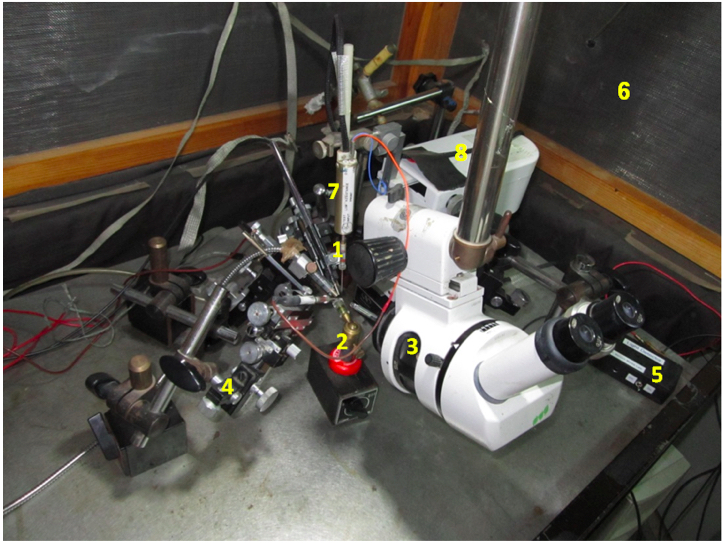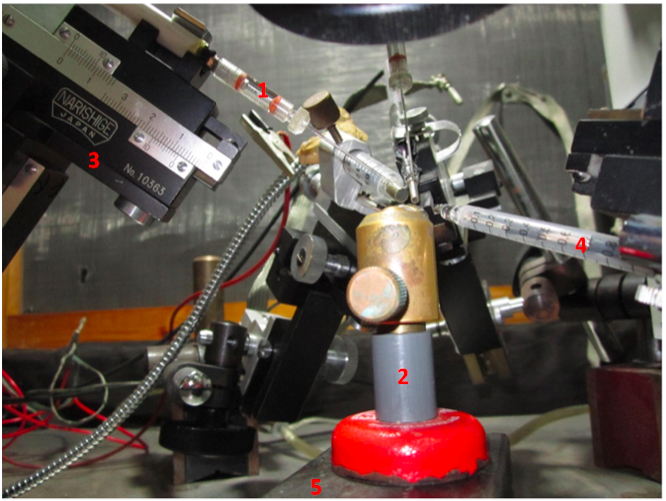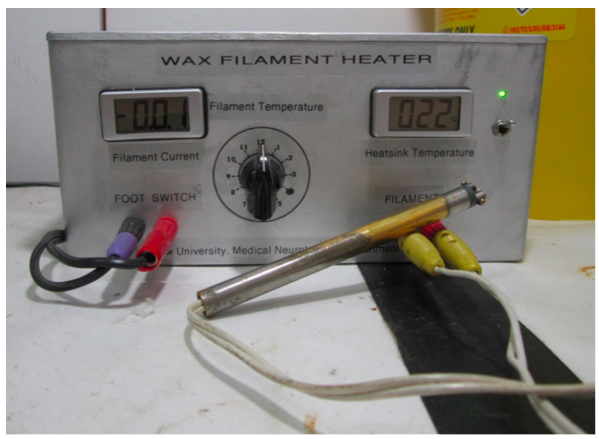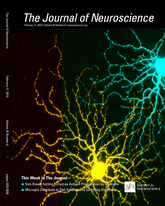- EN - English
- CN - 中文
Electroretinogram (ERG) Recordings from Drosophila
果蝇视网膜电图(ERG)记录
(*contributed equally to this work) 发布: 2015年11月05日第5卷第21期 DOI: 10.21769/BioProtoc.1636 浏览次数: 16020
评审: Oneil G. BhalalaMasahiro MoritaFabiana Scornik
Abstract
Phototransduction is a process in which light is converted into electrical signals used by the central nervous system. Invertebrate phototransduction is a process mediated by the phosphoinositide signaling cascade, characterized by Phospholipase C (PLC) as the effector enzyme and the Transient Receptor Potential (TRP) channels as its target. The great advantage of using invertebrate photoreceptors is the simplicity of the preparation, the ease of light stimulation, the robust expression of key molecular components, and most importantly, the ability to apply the power of molecular genetics. This last feature is mainly attributed to Drosophila melanogaster as a preferred animal model.
The Electroretinogram (ERG) is an extracellular voltage recording from the entire eye, which reflects the total electrical activity arising from the retina in response to a light stimulation. The Drosophila ERG light response is robust and easily obtained, thus making it a convenient method to identify defects in the light response as a result of mutations. The Prolonged Depolarizing Afterpotential (PDA) is a useful ERG phenomenon that can be recorded from white-eyed flies following intense blue light. It is induced by a massive photo-conversion of the photopigment rhodopsin to its dark stable state called metarhodopsin, due to failure of light response termination. Unlike the light coincident ERG recording, which declines quickly to the dark baseline after the cessation of the light stimulus, the PDA response continues long (hours) after light offset. However, this response can be suppressed to the dark baseline at any time by photo-conversion of metarhodopsin back to rhodopsin, by application of an intense orange light stimulus (see Figure 7; Minke, 2012). The PDA has been used as an important tool to screen for visual defective mutant (Minke, 2012).
Materials and Reagents
- Sterile disposable filter (0.2 μm pore size, aPES membrane, 75 mm diameter) [such as NalgeneTM Rapid-FlowTM Sterile Disposable Filter Units (Thermo Fisher Scientific)]
- 1 borosilicate glass capillary (OD 1.0 mm, ID 0.58 mm) (Harvard Apparatus)
- 3 silver filaments (1 mm diameter, 10 cm length) [such as Electrode AG/AGCL 1 mm DIA (WPI)]
- 1 ml/2 ml Syringe + 1 ml/2 ml Syringe with elongated tip [such as MEDI-PLUS 1ml without needle (KDL Medical Product Company)]
- Syringe filter (0.22 μm pore size, suitable for a 4 mm syringe tip) with PVDF membrane [such as Millex-GV Syringe Driven Filter Unit (Merck Millipore Corporation)]
- White-eyed Drosophila flies (available for purchase at Bloomington Drosophila Stock Center)
Note: Red-eyed Drosophila flies are also suitable for ERG recordings, but a PDA cannot be induced in these flies. - Homemade low temperature melting wax composed of mixture of paraffin and bee wax
- Redux cream for electrocardiography [such as Redux Electrolyte Crème (Parker Laboratories)]
- Ringer’s solution (see Recipes)
Equipment
- Horizontal Micropipette puller [such as programmable Flaming/Brown type micropipette puller (Sutter Instrument Company, model: P-97 )] with platinum filament. Less expensive pullers [such as Narishige vertical puller (NARISHIGE Group, model: PP-830 )] can also be used
- Pulsed gas flow anesthesia system with injector [such as the Sleeper system (Inject+Matic Sleeper)] connected to CO2 tank
- Fly stand [such as Alnico Shallow Pot Magnet (Eclipse Magnetics)] (Figure 1, #2, Figure 2, #2 and Video 1)
- Fine tweezers [such as tweezers (Biologie, model: number 5 )] and fine paint brush [such as paint brush (Rekab, model: series 40, number 3 )]
- Homemade Wax filament heater + soldering iron composed of a platinum-iridium (0.25 mm diameter) filament and a holder (Figure 3)
- Dissecting Stereoscopic zoom Microscope [such as Nikon Stereozoom Microscope (Nikon Corporation, model: SMZ-2 )]
- “Cold” illuminator [such as KL 1500 LCD (SCHOTT North America, model: KL 1500 LCD )] with heat and red filters [such as KG3 and RG620, respectively (SCHOTT North America, models: KG3 and RG620 )]
- Computer with electric signal processor (such as Clampex) and data analysis program (such as Clampfit)
- Stereo-microscope with at least 4 different magnification settings [such as the Wild M5 (Leica Microsystems) with 6, 12, 25 and 50 magnification settings] (see Figure 1, #3 and Video 1)
- Vibration Isolated Table
- Dark Faraday cage covered in black cloth (Figure 1, #6 and Video 1).
- On/Off magnet block to provide convenient placement of the fly stand [such as complete Magnetic Base (Eclipse Magnetics, model: E905 )] (Figure 2, #5 and Video 1)
- 4 triple axis coarse mechanical micromanipulators [such as the Three-Axis Compact Coarse Micromanipulator (Tritech Research, Narishige, model: M-2 )] (Figure 1, #4, Figure 2, #3 and Video 1)
- 1 triple axis, fine, very stable mechanical micromanipulator for holding the recording electrode [such as the Leitz Mechanical Micromanipulator (Leica Microsystems)] (Figure 1, #8)
- Light detector phototransistor for light monitoring (to be fixed on one of the micromanipulators) (Figure 1, #5, Figure 2, #4 and Video 1).
- Shutter system [such as LS2 2 mm Uni-stable Shutters (Uniblitz, Vincent Associates®)] + shutter driver [such as VCM-D1 Single Channel Uni-stable (Uniblitz, Vincent Associates®)]
- High-pressure ozone-free 75 W Xenon lamp (operating on 50 W) + Schott KG3 heat filter + 2 condenser lenses + fiber optic (3 mm diameter, 1.3 m long) conducting light into the Faraday cage for light stimulation
- Lamp power supply (such as PTI LPS-220)
- Data acquisition system [such as Digidata 1550 digitizer (Molecular Devices, model: Digidata 1550 digitizer )]
- 2 glass electrode holders suitable for capillary O.D. 1 mm (Figure 1, #1, Figure 2, #1 and Video 1)
- Microelectrode preamplifier system with head-stage impedance tester, at least x10 amplification [such as Extracellular Preamplifier Current Pump System (Dagan, model: 2400A )] (Figure 1, #7 and Video 1)
- Pulse generator [such as Master 8 and Master 9 (A.M.P.I, models: Master 8 and Master 9 )]
- Neutral Density (ND) filters [such as ND filters (Balzer) and color filters including Red (SCHOTT North America, model: RG610 ), Orange (SCHOTT North America, model: OG590 ) and Blue (SCHOTT North America, model: BG63 )]

Figure 1. An overview of the ERG setup. #1-electrode holder, #2-fly stand, #3- stereo-microscope, #4-micromanipulator, #5-light detector phototransistor, #6- Faraday cage, #7-amplifier head-stage, #8-Leica-Leitz Mechanical Micromanipulator.
Figure 2. A magnified view of the ERG setup. #1-electrode holder, #2-fly stand, #3- micromanipulator, #4-light detector probe, #5-magnet block.
Figure 3. A homemade instrument for immobilizing the living fly. A platinum-iridium (0.25 mm diameter) filament is electrically connected to a power supply with a controlled current output. The filament is attached via insolating plastic to a copper rod holder (heater and soldering iron).
Video 1. A general overview of the ERG set
Procedure
文章信息
版权信息
© 2015 The Authors; exclusive licensee Bio-protocol LLC.
如何引用
Readers should cite both the Bio-protocol article and the original research article where this protocol was used:
- Rhodes-Mordov, E., Samra, H. and Minke, B. (2015). Electroretinogram (ERG) Recordings from Drosophila. Bio-protocol 5(21): e1636. DOI: 10.21769/BioProtoc.1636.
-
Weiss, S., Kohn, E., Dadon, D., Katz, B., Peters, M., Lebendiker, M., Kosloff, M., Colley, N. J. and Minke, B. (2012). Compartmentalization and Ca2+ buffering are essential for prevention of light-induced retinal degeneration. J Neurosci 32(42): 14696-14708.
分类
神经科学 > 神经解剖学和神经环路
神经科学 > 感觉和运动系统
您对这篇实验方法有问题吗?
在此处发布您的问题,我们将邀请本文作者来回答。同时,我们会将您的问题发布到Bio-protocol Exchange,以便寻求社区成员的帮助。
Share
Bluesky
X
Copy link













